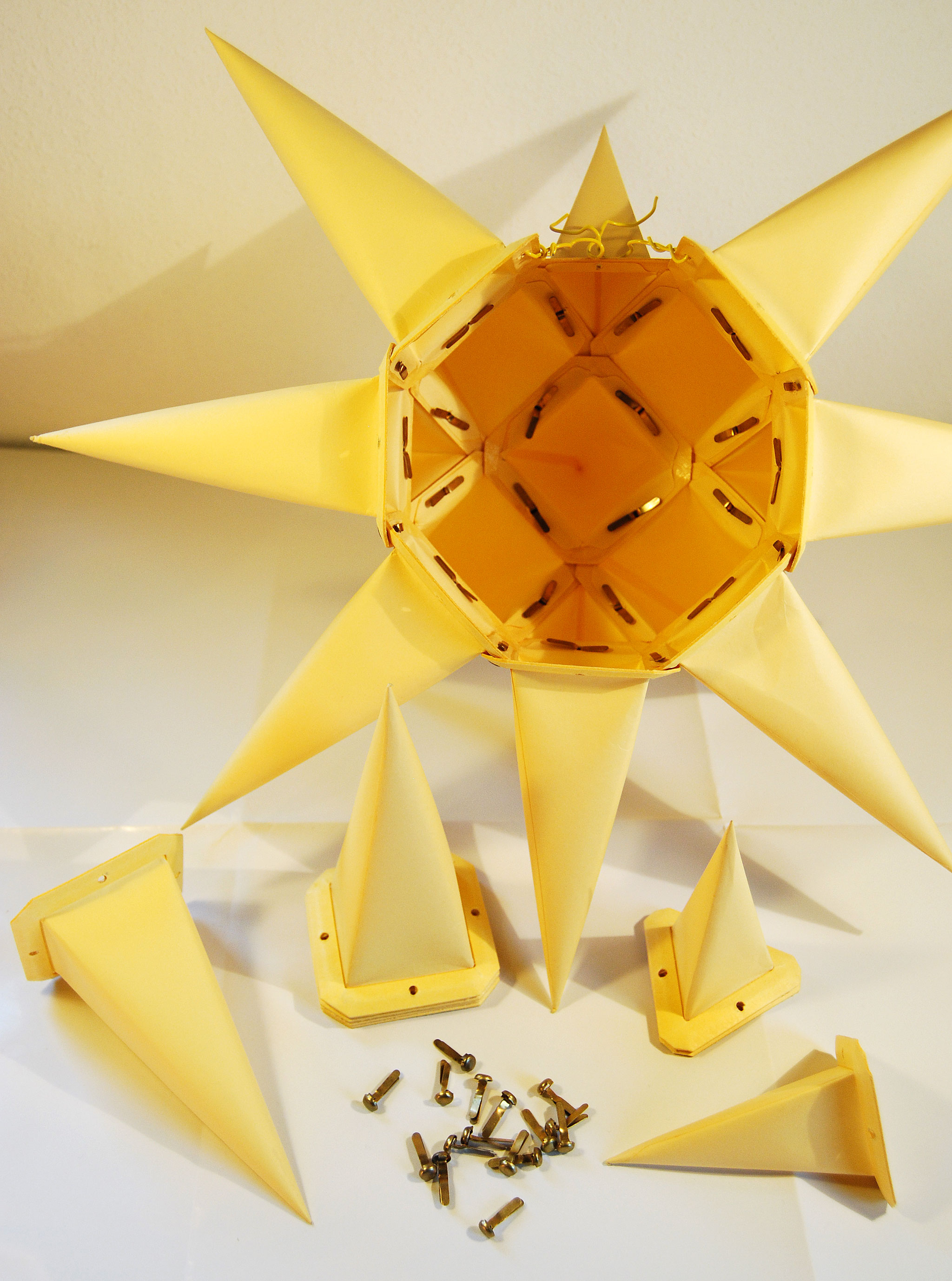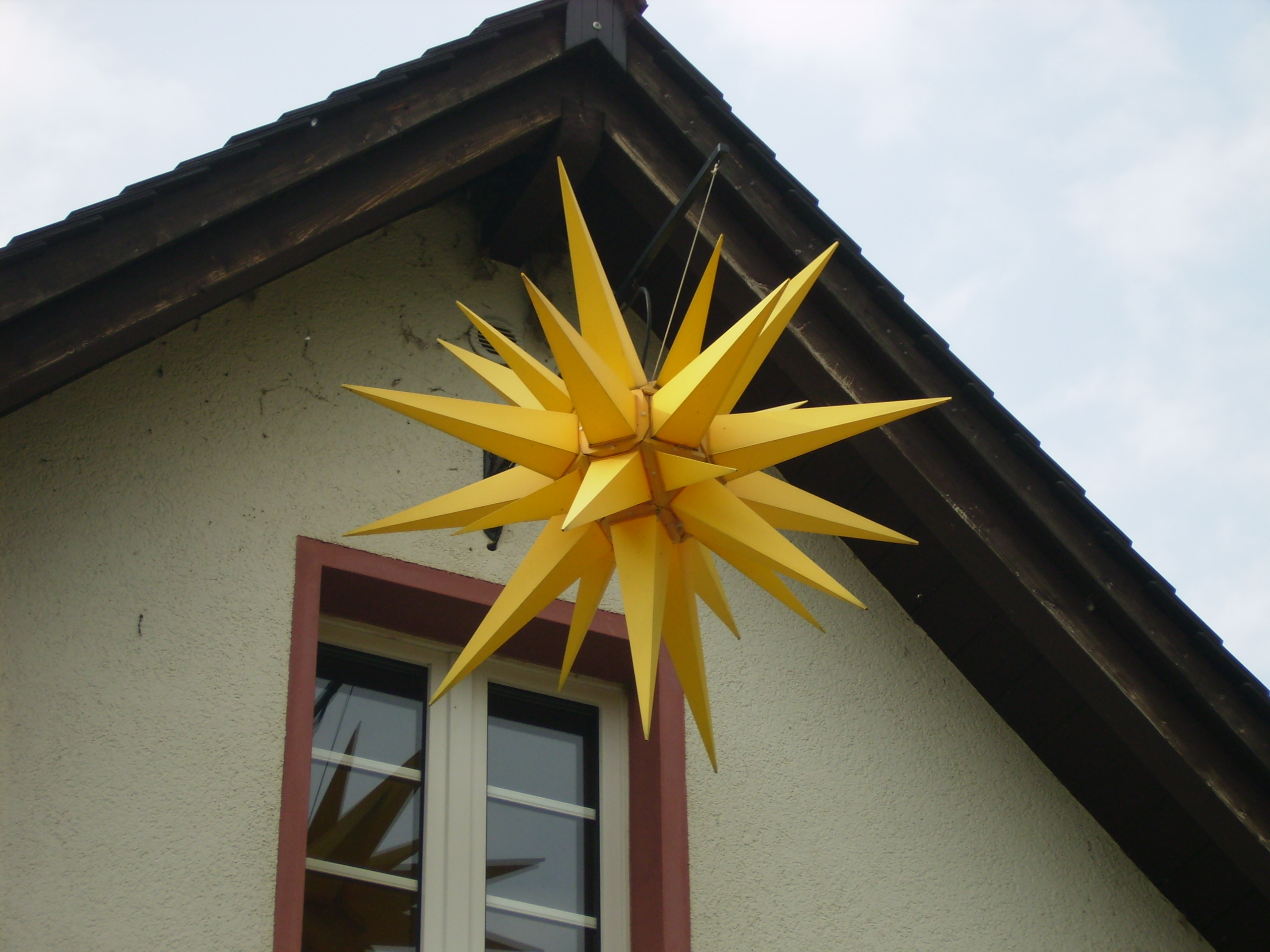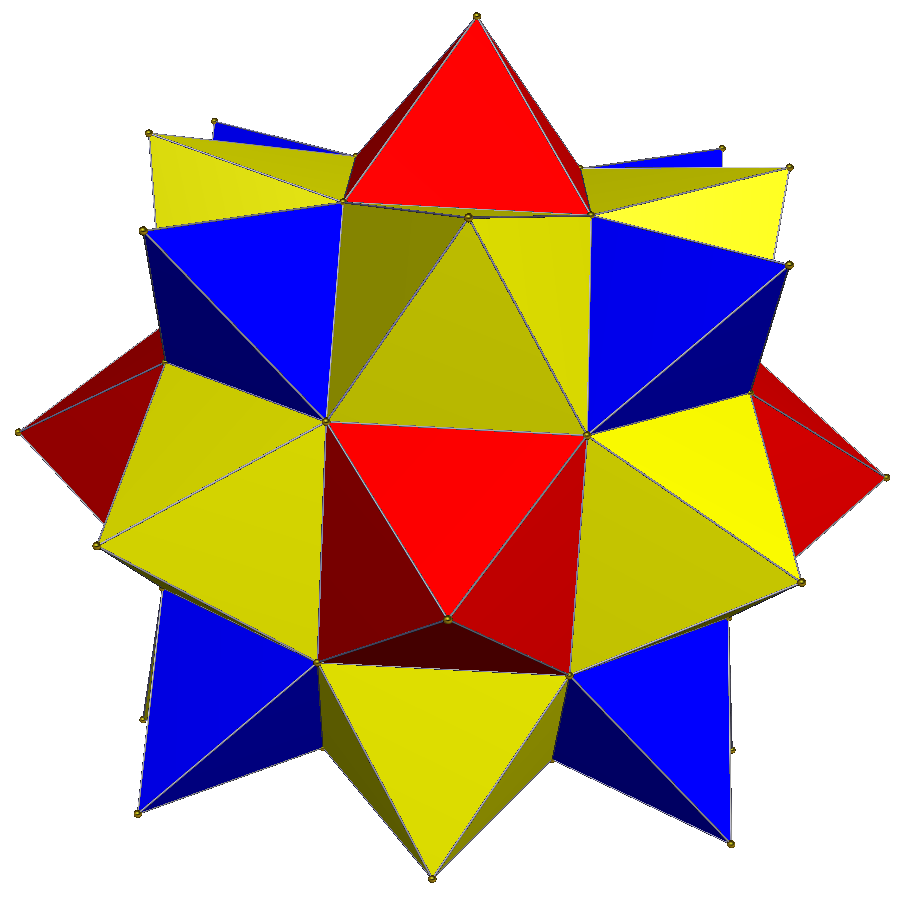Moravian star on:
[Wikipedia]
[Google]
[Amazon]

 A Moravian star () is an illuminated decoration used during the Christian liturgical seasons of
A Moravian star () is an illuminated decoration used during the Christian liturgical seasons of
 The original Moravian star as manufactured in Herrnhut since 1897 exists only in a 26-point form, composed of eighteen square and eight triangular cone-shaped points. The 26th point is missing and used for mounting. This shape is technically known as a Kleetope of a
The original Moravian star as manufactured in Herrnhut since 1897 exists only in a 26-point form, composed of eighteen square and eight triangular cone-shaped points. The 26th point is missing and used for mounting. This shape is technically known as a Kleetope of a
Make a German Froebel Star Ornament
Make a Moravian Star
Hardwood Moravian Stars
{{Christmas Christmas decorations Christmas in Germany Traditions of the Moravian Church Herrnhut Niesky Advent Star symbols

Advent
Advent is a season observed in most Christian denominations as a time of waiting and preparation for both the celebration of Jesus's birth at Christmas and the return of Christ at the Second Coming. It begins on the fourth Sunday before Chri ...
, Christmas
Christmas is an annual festival commemorating Nativity of Jesus, the birth of Jesus Christ, observed primarily on December 25 as a Religion, religious and Culture, cultural celebration among billions of people Observance of Christmas by coun ...
, and Epiphany representing the Star of Bethlehem
The Star of Bethlehem, or Christmas Star, appears in the nativity of Jesus, nativity story of the Gospel of Matthew Matthew 2, chapter 2 where "wise men from the East" (biblical Magi, Magi) are inspired by the star to travel to Jerusalem. There, ...
pointing towards the infant Jesus. The Moravian Church
The Moravian Church, or the Moravian Brethren ( or ), formally the (Latin: "Unity of the Brethren"), is one of the oldest Protestant denominations in Christianity, dating back to the Bohemian Reformation of the 15th century and the original ...
teaches:
The Moravian star is popular in places where there are Moravian Christian congregations world wide. The stars take their English name from the Moravian Church
The Moravian Church, or the Moravian Brethren ( or ), formally the (Latin: "Unity of the Brethren"), is one of the oldest Protestant denominations in Christianity, dating back to the Bohemian Reformation of the 15th century and the original ...
, originating in Moravia
Moravia ( ; ) is a historical region in the eastern Czech Republic, roughly encompassing its territory within the Danube River's drainage basin. It is one of three historical Czech lands, with Bohemia and Czech Silesia.
The medieval and early ...
. In Germany, they are known as Herrnhut
Herrnhut (; ; ; Upper Lusatian: ''Harrnhutt'', ''Harrnutt'') is a town of around 6,000 inhabitants in Upper Lusatia, in the district of Görlitz, in eastern Saxony, Germany. The town is mainly known as the place of origin of the community of t ...
stars, named after the Moravian Mother Community in Saxony
Saxony, officially the Free State of Saxony, is a landlocked state of Germany, bordering the states of Brandenburg, Saxony-Anhalt, Thuringia, and Bavaria, as well as the countries of Poland and the Czech Republic. Its capital is Dresden, and ...
, Germany
Germany, officially the Federal Republic of Germany, is a country in Central Europe. It lies between the Baltic Sea and the North Sea to the north and the Alps to the south. Its sixteen States of Germany, constituent states have a total popu ...
, where they were first commercially produced. With the rise of ecumenism
Ecumenism ( ; alternatively spelled oecumenism)also called interdenominationalism, or ecumenicalismis the concept and principle that Christians who belong to different Christian denominations should work together to develop closer relationships ...
, the use of the Moravian star has spread beyond the Moravian Church to other Christian denominations, such as the Lutheran Church and Catholic Church, as well as the Methodist Church.
History
The first Moravian star is known to have originated in the 1830s at the Moravian Boys' School inNiesky
Niesky (; Polish and Sorbian: ''Niska'' ; ) is a small town in Upper Lusatia in eastern Saxony, Germany. It has a population of about 9,200 (2020) and is part of the district of Görlitz.
Historically considered part of Upper Lusatia, it was a ...
, Germany, as a geometry lesson or project. The first mention is of a 110-point star for the 50th anniversary of the ''Paedagogium'' (classical school for boys) in Niesky. Around 1880, Peter Verbeek, an alumnus of the school, began making the stars and their instructions available for sale through his bookstore. His son Harry went on to found the Herrnhut
Herrnhut (; ; ; Upper Lusatian: ''Harrnhutt'', ''Harrnutt'') is a town of around 6,000 inhabitants in Upper Lusatia, in the district of Görlitz, in eastern Saxony, Germany. The town is mainly known as the place of origin of the community of t ...
Star Factory, which was the main source of stars until World War I
World War I or the First World War (28 July 1914 – 11 November 1918), also known as the Great War, was a World war, global conflict between two coalitions: the Allies of World War I, Allies (or Entente) and the Central Powers. Fighting to ...
. Although heavily damaged at the end of World War II
World War II or the Second World War (1 September 1939 – 2 September 1945) was a World war, global conflict between two coalitions: the Allies of World War II, Allies and the Axis powers. World War II by country, Nearly all of the wo ...
, the Star Factory resumed manufacturing them. Briefly taken over by the government of East Germany
East Germany, officially known as the German Democratic Republic (GDR), was a country in Central Europe from Foundation of East Germany, its formation on 7 October 1949 until German reunification, its reunification with West Germany (FRG) on ...
in the 1950s, the factory was returned to the Moravian Church-owned Abraham Dürninger Company, which continues to make the stars in Herrnhut. Other star-making companies and groups have sprung up since then. Some Moravian congregations have congregation members who build and sell the stars as fund raisers.
Cultural and Religious importance
The star was soon adopted throughout the Moravian Church as anAdvent
Advent is a season observed in most Christian denominations as a time of waiting and preparation for both the celebration of Jesus's birth at Christmas and the return of Christ at the Second Coming. It begins on the fourth Sunday before Chri ...
symbol.
Moravian stars continue to be displayed during Advent, Christmas, and Epiphany throughout the world, even in areas without a significant Moravian Church presence. Many Moravian households display their stars year-round. The stars are often seen in Moravian nativity and Christmas village displays as a representation of the Star of Bethlehem
The Star of Bethlehem, or Christmas Star, appears in the nativity of Jesus, nativity story of the Gospel of Matthew Matthew 2, chapter 2 where "wise men from the East" (biblical Magi, Magi) are inspired by the star to travel to Jerusalem. There, ...
pointing towards the infant Jesus. They are properly displayed from the first Sunday in Advent (the fourth Sunday before Christmas) until the Festival of Epiphany (January 6). Large advent stars shine in the dome of the Frauenkirche in Dresden
Dresden (; ; Upper Saxon German, Upper Saxon: ''Dräsdn''; , ) is the capital city of the States of Germany, German state of Saxony and its second most populous city after Leipzig. It is the List of cities in Germany by population, 12th most p ...
and over the altar of the Thomaskirche
The St. Thomas Church () is a Lutheran church in Leipzig, Germany, located at the western part of the inner city ring road in Leipzig's central district. Martin Luther preached in the church in 1539. It is associated with several well-known ...
in Leipzig
Leipzig (, ; ; Upper Saxon: ; ) is the most populous city in the States of Germany, German state of Saxony. The city has a population of 628,718 inhabitants as of 2023. It is the List of cities in Germany by population, eighth-largest city in Ge ...
. A Moravian star, one of the largest in the world, sits atop the North Tower of Atrium Health Wake Forest Baptist during the Advent and Christmas seasons. The city of Winston-Salem, North Carolina
North Carolina ( ) is a U.S. state, state in the Southeastern United States, Southeastern region of the United States. It is bordered by Virginia to the north, the Atlantic Ocean to the east, South Carolina to the south, Georgia (U.S. stat ...
, which traces its origins to Salem has Moravian origins dating to 1766, uses the Moravian star as their official Christmas street decoration. Another star sits under Wake Forest University
Wake Forest University (WFU) is a private research university in Winston-Salem, North Carolina, United States. Founded in 1834, the university received its name from its original location in Wake Forest, north of Raleigh, North Carolina. The R ...
's Wait Chapel during the Advent and Christmas seasons as well.
The use of the stars during the Advent, Christmas, and Epiphany seasons is also a tradition in the West Indies
The West Indies is an island subregion of the Americas, surrounded by the Atlantic Ocean, North Atlantic Ocean and the Caribbean Sea, which comprises 13 independent island country, island countries and 19 dependent territory, dependencies in thr ...
, Greenland
Greenland is an autonomous territory in the Danish Realm, Kingdom of Denmark. It is by far the largest geographically of three constituent parts of the kingdom; the other two are metropolitan Denmark and the Faroe Islands. Citizens of Greenlan ...
, Suriname
Suriname, officially the Republic of Suriname, is a country in northern South America, also considered as part of the Caribbean and the West Indies. It is a developing country with a Human Development Index, high level of human development; i ...
, Labrador
Labrador () is a geographic and cultural region within the Canadian province of Newfoundland and Labrador. It is the primarily continental portion of the province and constitutes 71% of the province's area but is home to only 6% of its populatio ...
, Central America
Central America is a subregion of North America. Its political boundaries are defined as bordering Mexico to the north, Colombia to the southeast, the Caribbean to the east, and the Pacific Ocean to the southwest. Central America is usually ...
, South
South is one of the cardinal directions or compass points. The direction is the opposite of north and is perpendicular to both west and east.
Etymology
The word ''south'' comes from Old English ''sūþ'', from earlier Proto-Germanic ''*sunþa ...
and East Africa
East Africa, also known as Eastern Africa or the East of Africa, is a region at the eastern edge of the Africa, African continent, distinguished by its unique geographical, historical, and cultural landscape. Defined in varying scopes, the regi ...
, Ladakh
Ladakh () is a region administered by India as a union territory and constitutes an eastern portion of the larger Kashmir region that has been the subject of a Kashmir#Kashmir dispute, dispute between India and Pakistan since 1947 and India an ...
in India
India, officially the Republic of India, is a country in South Asia. It is the List of countries and dependencies by area, seventh-largest country by area; the List of countries by population (United Nations), most populous country since ...
, and in parts of Scandinavia: wherever the Moravian Church has sent missionaries.
In 2020, as the world descended in to the Covid-19 pandemic, Moravians began to ring, rehang their stars as a sign of love, hope and peace during dark times. On March 27, 2020 Atrium Health Wake Forest Baptist reinstalled their 31 foot star, a top the North Tower.
Types of stars
 The original Moravian star as manufactured in Herrnhut since 1897 exists only in a 26-point form, composed of eighteen square and eight triangular cone-shaped points. The 26th point is missing and used for mounting. This shape is technically known as a Kleetope of a
The original Moravian star as manufactured in Herrnhut since 1897 exists only in a 26-point form, composed of eighteen square and eight triangular cone-shaped points. The 26th point is missing and used for mounting. This shape is technically known as a Kleetope of a rhombicuboctahedron
In geometry, the rhombicuboctahedron is an Archimedean solid with 26 faces, consisting of 8 equilateral triangles and 18 squares. It was named by Johannes Kepler in his 1618 Harmonices Mundi, being short for ''truncated cuboctahedral rhombus'', w ...
. Each face of the geometric solid in the middle, the rhombicuboctahedron, serves as the base for one of the pyramid augmentations or starburst points. This is the most commonly seen and most widely available form of Christmas star.
Other forms of Christmas star exist, which differ from the original Herrnhut Moravian star. No matter how many points a star has, it has a symmetrical shape based on polyhedra
In geometry, a polyhedron (: polyhedra or polyhedrons; ) is a three-dimensional figure with flat polygonal faces, straight edges and sharp corners or vertices. The term "polyhedron" may refer either to a solid figure or to its boundary su ...
. There are other stars with 20, 32, 50, 62 and 110 points that are commonly hand-made. The variety comes from various ways of forming the polyhedron that provides a base for the points—using an octagonal face instead of a square face, for example. The common original Herrnhut Moravian star becomes a 50-point star when the squares and triangles that normally make up the faces of the polyhedron become octagons and hexagons. This leaves a 4-sided trapezoidal
In geometry, a trapezoid () in North American English, or trapezium () in British English, is a quadrilateral that has at least one pair of parallel sides.
The parallel sides are called the ''bases'' of the trapezoid. The other two sides are ...
hole in the corners of the faces which is then filled with an irregular four sided point. These 4-sided points form a "starburst" in the midst of an otherwise regular 26-point star.
Froebel stars, which are paper decorations made from four folded strips of paper, are sometimes inaccurately also called Moravian stars, among many other names.
See also
* Christingle * Illumination (decoration) * Lovefeast *Nativity scene
In the Christian tradition, a nativity scene (also known as a manger scene, crib, crèche ( or ), or in Italian ''presepio'' or ''presepe'', or Bethlehem) is the special exhibition, particularly during the Christmastide, Christmas season, of ar ...
References
External links
Make a German Froebel Star Ornament
Make a Moravian Star
Hardwood Moravian Stars
{{Christmas Christmas decorations Christmas in Germany Traditions of the Moravian Church Herrnhut Niesky Advent Star symbols